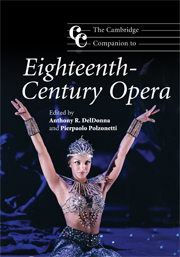Book contents
- Frontmatter
- Part I The making of opera
- 1 Opera as process
- 2 Aria as drama
- 3 Ensembles and finales
- 4 Metastasio: the dramaturgy of eighteenth-century heroic opera
- 5 Roles and acting
- 6 Ballet
- 7 Orchestra and voice in eighteenth-century Italian opera
- 8 To look again (at Don Giovanni)
- Part II National styles and genres
- Notes
- Bibliography
- Index
1 - Opera as process
from Part I - The making of opera
Published online by Cambridge University Press: 28 September 2011
- Frontmatter
- Part I The making of opera
- 1 Opera as process
- 2 Aria as drama
- 3 Ensembles and finales
- 4 Metastasio: the dramaturgy of eighteenth-century heroic opera
- 5 Roles and acting
- 6 Ballet
- 7 Orchestra and voice in eighteenth-century Italian opera
- 8 To look again (at Don Giovanni)
- Part II National styles and genres
- Notes
- Bibliography
- Index
Summary
Production and re-production
Eighteenth-century opera is experiencing an unprecedented revitalization. New productions are increasingly presented to us in a manner that resonates as much as possible with our modern sensibilities, such as McVicar's recent staging of Handel's Giulio Cesare, set in British colonial style with Bollywood-inspired choreography (see cover illustration). Although productions of the same opera in the eighteenth century and in our time result in theatrical events that on the surface seem radically dissimilar, they also share fundamental traits. No matter how distant the story of an opera is set in time or in space, opera was and still is meant to engage with the present audience. To do so, it places the audience at the forefront of the performing event by adopting a system of production that favors re-creation over re-production, or process over work. In this chapter I will examine who and what was involved in this process and how it functions in contemporary practices. The basis of this investigation is Vivaldi's Motezuma (Venice, 1733), which exists in two modern and completely different recorded versions. A close reading of this work can reveal the process through which opera was produced and disseminated in the eighteenth century as well as the techniques of creative philology that are practiced in our contemporary production of early opera. As demonstrated in later settings of the Montezuma story beginning with Graun's version (Berlin, 1755), the reform of opera, which was famously exacted by Gluck, attempted to address some of the problems related to a system of production that was perceived as too chaotic and diffuse.
- Type
- Chapter
- Information
- The Cambridge Companion to Eighteenth-Century Opera , pp. 1 - 23Publisher: Cambridge University PressPrint publication year: 2009



